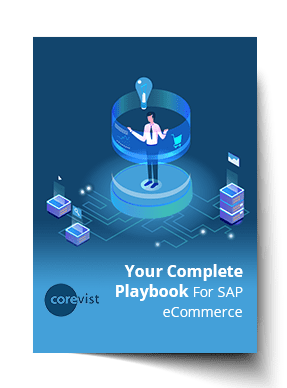Share
Author
Damian Dellavecchia
Share
Originally published Aug 8, 2018. Refreshed Aug 18, 2021.
In 2021, it’s critical to show pricing in B2B eCommerce. No ifs, ands, or buts—your customers need to know what they’re going to pay for your product or service.
Sounds simple on the surface, but it’s not simple at all—especially if you have complex, customer-specific pricing rules built out in SAP. How do ensure that your B2B eCommerce experience reflects the right pricing for every user, with every combination of products, every time?
Here are 6 keys to nailing your B2B eCommerce pricing.
1. You risk losing the sale without accurate, personalized pricing in B2B eCommerce
Whether we’re talking about the catalog or the cart experience, pricing isn’t optional in B2B eCommerce. If customers have to call in to get accurate pricing, then B2B eCommerce functions as nothing but brochureware. Without customer-specific pricing, your web portal can’t replace phone, fax, and email ordering.
Don’t underestimate customer frustration here. In some markets, lack of pricing could cost you the sale. This is especially true if customers can pull up a competitor’s B2B eCommerce store in a heartbeat and get satisfactory pricing there.
Doom and gloom aside, displaying pricing is one way you show care for your customers. If you strive to meet their needs in every other way, you should strive to provide pricing in your SAP webshop, too.
2. You can offer accurate pricing through real-time integration to SAP
Real-time integration to SAP is crucial for inventory availability, but is it necessary for pricing?
We believe it is. Here’s why.
Pricing may not change frequently, but the calculations that deliver pricing are often complicated, and they live in SAP. Taking a complicated pricing model and migrating it over from SAP onto another platform is problematic. Either you simplify the pricing, so it’s easy to move over from an IT perspective, or you find a way to show real-time pricing from SAP in B2B eCommerce.
That’s the challenge. At Corevist, we solve it by displaying prices from SAP in real time. That means that the customer gets background calculations for pricing based on their SAP sold-to and any other factors that are relevant in SAP and/or the cart.
Why does this matter? Because inaccurate pricing adds friction to the buying process. It disturbs customer budgets if the displaying price is wrong. If customers feel uncertain about pricing, that requires a human touch from Customer Service as well as back-and-forth communication. Ultimately, that slows down the purchasing process—when accurate pricing from SAP is only an integration away.
How to nail it:
Display real-time SAP pricing in your B2B eCommerce store. (Hint: This is just one of the 53 prebuilt SAP integration points that all Corevist solutions include.) Real-time pricing from SAP ensures that buyers get the same SAP-calculated prices in the web portal that they would get over the phone if they called a CSR. This makes you easier to do business with.
3. Audit existing SAP pricing rules and simplify when possible
SAP pricing procedures can get pretty complex. There are three output types for SAP documents that display pricing: SAP SmartForm, SAPscript, or PDF. Each of these documents can display final pricing, and that pricing is controlled by print flags. Print flags inform the output types on how the pricing should appear in the output document.
The best practice is to use those print flags, as opposed to customizing the output forms, which just creates more work in the long run. In fact, if you use print flags wisely, Corevist Commerce reads them seamlessly and “prints” accurate pricing in the web store. Consider the newer print flags, the ‘X’ and ‘S’ in the pricing procedure are old ones that are not optimized. For example, if you want the zero dollar net value to show on the web (say for a free item), you need to update the pricing procedure print flag’s from ‘X’ to ‘a’. See this link for further details:
https://archive.sap.com/discussions/thread/1282802
SAP pricing procedures should always be optimized to remove unnecessary overhead in processing. This is especially true when it comes to B2B eCommerce integrated to SAP in real time. The simpler your pricing procedures, the less processing overhead you invoke, which means a better experience for your customers.
How to nail it:
If possible, simplify unnecessary pricing logic within SAP. That way, customers get clear, accurate prices in your B2B ordering portal.
4. Consider shipping calculations
Not all businesses are prepared to give the full price upon checkout. In many cases, that’s because they can’t calculate shipping costs until the warehouse team is physically ready to ship the product. Only then can they package the shipment, weigh it, and create an updated invoice.
That practice is common in B2B eCommerce, with both manufacturers and distributors. But along with the consumerization of B2B (evolution toward a B2C-style UX), we’re seeing increasing demand for an actual, final price upon checkout. One day, even the most old-school manufacturers may have to evolve to accommodate this preference.
There are multiple ways to handle this. Some of our clients have decided that they’ll pay the shipping charges themselves. In that case, your B2B web shop needs to accommodate that option.
Companies that want to pass shipping cost to the customer can offer freight shopping within the B2B eCommerce experience. We partner with companies like ShipERP for this. It’s a great option for manufacturers who want to provide a final price but don’t want to take on the cost of shipping, which can be quite high due to B2B order sizes.
How to nail it:
Define what type of shipping option you’ll offer in B2B eCommerce. Whether you choose to absorb the cost of shipping yourself, or offer rate shopping among shippers, make sure your final order price takes shipping into account.
5. Consider tax calculations
Taxes aren’t always involved in B2B transactions. Still, if your market has any potential to be taxable, you need tax logic built in to your B2B eCommerce store. That software has two jobs:
- Figure out if the transaction is taxable.
- If it is, calculate the tax.
Your B2B cart has to integrate with your tax software. Corevist Commerce integrates with Taxware for tax calculations.
How to nail it:
Cover your bases by including tax calculation in your B2B eCommerce solution.
6. Real-time pricing helps you upsell for more revenue
Real-time pricing really shines for B2B companies who want to use B2B eCommerce not only for increased efficiency, but also increased revenue.
Why? Because the combination of B2B eCommerce + real-time SAP pricing rules allows you to upsell/cross-sell within the web shop.
That can take all kinds of forms, both in the catalog and the cart. Here are some examples:
- Related product bundling—Offer product Y at a discount if product X is purchased
- Price break by quantity—Offer a better unit price if the customer orders more than a certain amount
- Price break by shipping configuration—Offer a better unit price across multiple products if the customer’s order creates a complete pallet, truckload, etc.
How to nail it:
Define how cross-selling/upselling can offer value in your market. Establish those product relationships and price bundles in SAP, and express them in the web store through a real-time integration.
NEW Guide:
Your Complete Playbook for SAP eCommerce
Here are 4 keys to a successful eCommerce channel in an SAP ERP scenario.









